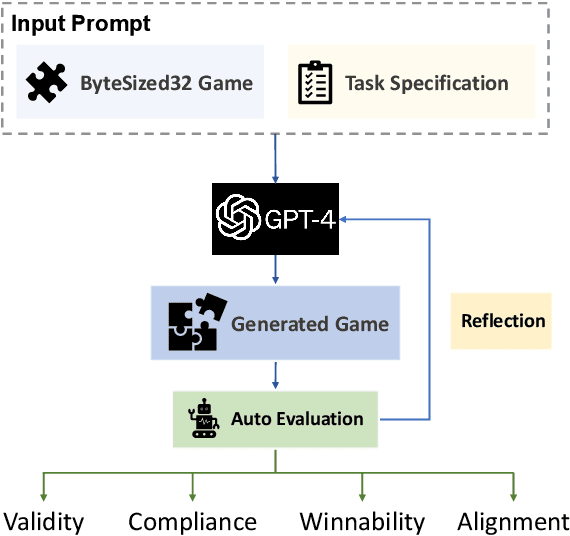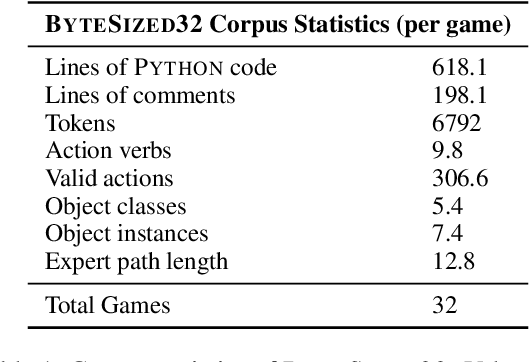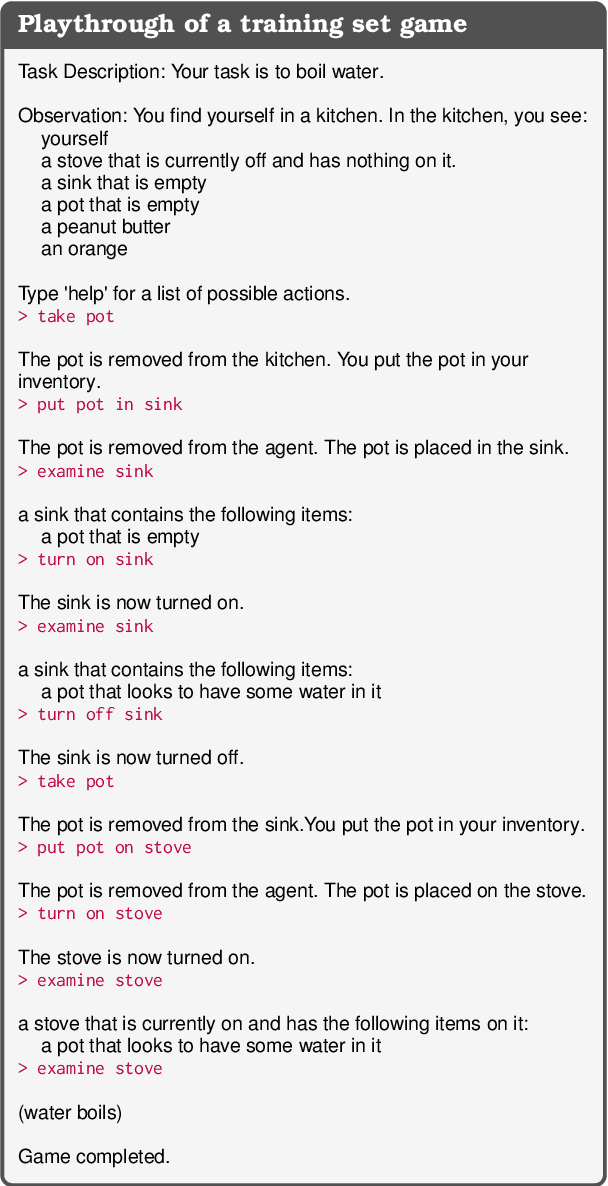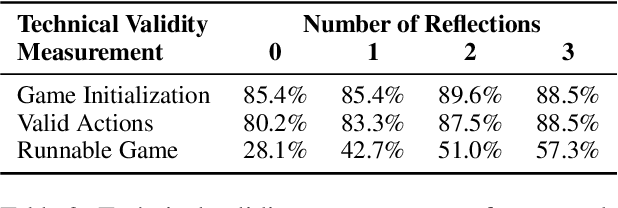Marc-Alexandre Côté
debug-gym: A Text-Based Environment for Interactive Debugging
Mar 27, 2025Abstract:Large Language Models (LLMs) are increasingly relied upon for coding tasks, yet in most scenarios it is assumed that all relevant information can be either accessed in context or matches their training data. We posit that LLMs can benefit from the ability to interactively explore a codebase to gather the information relevant to their task. To achieve this, we present a textual environment, namely debug-gym, for developing LLM-based agents in an interactive coding setting. Our environment is lightweight and provides a preset of useful tools, such as a Python debugger (pdb), designed to facilitate an LLM-based agent's interactive debugging. Beyond coding and debugging tasks, this approach can be generalized to other tasks that would benefit from information-seeking behavior by an LLM agent.
Enhancing Agent Learning through World Dynamics Modeling
Jul 25, 2024Abstract:While large language models (LLMs) have been increasingly deployed across tasks in language understanding and interactive decision-making, their impressive performance is largely due to the comprehensive and in-depth domain knowledge embedded within them. However, the extent of this knowledge can vary across different domains. Existing methods often assume that LLMs already possess such comprehensive and in-depth knowledge of their environment, overlooking potential gaps in their understanding of actual world dynamics. To address this gap, we introduce Discover, Verify, and Evolve (DiVE), a framework that discovers world dynamics from a small number of demonstrations, verifies the correctness of these dynamics, and evolves new, advanced dynamics tailored to the current situation. Through extensive evaluations, we analyze the impact of each component on performance and compare the automatically generated dynamics from DiVE with human-annotated world dynamics. Our results demonstrate that LLMs guided by DiVE can make better decisions, achieving rewards comparable to human players in the Crafter environment.
IDAT: A Multi-Modal Dataset and Toolkit for Building and Evaluating Interactive Task-Solving Agents
Jul 12, 2024



Abstract:Seamless interaction between AI agents and humans using natural language remains a key goal in AI research. This paper addresses the challenges of developing interactive agents capable of understanding and executing grounded natural language instructions through the IGLU competition at NeurIPS. Despite advancements, challenges such as a scarcity of appropriate datasets and the need for effective evaluation platforms persist. We introduce a scalable data collection tool for gathering interactive grounded language instructions within a Minecraft-like environment, resulting in a Multi-Modal dataset with around 9,000 utterances and over 1,000 clarification questions. Additionally, we present a Human-in-the-Loop interactive evaluation platform for qualitative analysis and comparison of agent performance through multi-turn communication with human annotators. We offer to the community these assets referred to as IDAT (IGLU Dataset And Toolkit) which aim to advance the development of intelligent, interactive AI agents and provide essential resources for further research.
Can Language Models Serve as Text-Based World Simulators?
Jun 10, 2024



Abstract:Virtual environments play a key role in benchmarking advances in complex planning and decision-making tasks but are expensive and complicated to build by hand. Can current language models themselves serve as world simulators, correctly predicting how actions change different world states, thus bypassing the need for extensive manual coding? Our goal is to answer this question in the context of text-based simulators. Our approach is to build and use a new benchmark, called ByteSized32-State-Prediction, containing a dataset of text game state transitions and accompanying game tasks. We use this to directly quantify, for the first time, how well LLMs can serve as text-based world simulators. We test GPT-4 on this dataset and find that, despite its impressive performance, it is still an unreliable world simulator without further innovations. This work thus contributes both new insights into current LLM's capabilities and weaknesses, as well as a novel benchmark to track future progress as new models appear.
DISCOVERYWORLD: A Virtual Environment for Developing and Evaluating Automated Scientific Discovery Agents
Jun 10, 2024



Abstract:Automated scientific discovery promises to accelerate progress across scientific domains. However, developing and evaluating an AI agent's capacity for end-to-end scientific reasoning is challenging as running real-world experiments is often prohibitively expensive or infeasible. In this work we introduce DISCOVERYWORLD, the first virtual environment for developing and benchmarking an agent's ability to perform complete cycles of novel scientific discovery. DISCOVERYWORLD contains a variety of different challenges, covering topics as diverse as radioisotope dating, rocket science, and proteomics, to encourage development of general discovery skills rather than task-specific solutions. DISCOVERYWORLD itself is an inexpensive, simulated, text-based environment (with optional 2D visual overlay). It includes 120 different challenge tasks, spanning eight topics each with three levels of difficulty and several parametric variations. Each task requires an agent to form hypotheses, design and run experiments, analyze results, and act on conclusions. DISCOVERYWORLD further provides three automatic metrics for evaluating performance, based on (a) task completion, (b) task-relevant actions taken, and (c) the discovered explanatory knowledge. We find that strong baseline agents, that perform well in prior published environments, struggle on most DISCOVERYWORLD tasks, suggesting that DISCOVERYWORLD captures some of the novel challenges of discovery, and thus that DISCOVERYWORLD may help accelerate near-term development and assessment of scientific discovery competency in agents. Code available at: www.github.com/allenai/discoveryworld
OPEx: A Component-Wise Analysis of LLM-Centric Agents in Embodied Instruction Following
Mar 05, 2024



Abstract:Embodied Instruction Following (EIF) is a crucial task in embodied learning, requiring agents to interact with their environment through egocentric observations to fulfill natural language instructions. Recent advancements have seen a surge in employing large language models (LLMs) within a framework-centric approach to enhance performance in embodied learning tasks, including EIF. Despite these efforts, there exists a lack of a unified understanding regarding the impact of various components-ranging from visual perception to action execution-on task performance. To address this gap, we introduce OPEx, a comprehensive framework that delineates the core components essential for solving embodied learning tasks: Observer, Planner, and Executor. Through extensive evaluations, we provide a deep analysis of how each component influences EIF task performance. Furthermore, we innovate within this space by deploying a multi-agent dialogue strategy on a TextWorld counterpart, further enhancing task performance. Our findings reveal that LLM-centric design markedly improves EIF outcomes, identify visual perception and low-level action execution as critical bottlenecks, and demonstrate that augmenting LLMs with a multi-agent framework further elevates performance.
Language-guided Skill Learning with Temporal Variational Inference
Feb 26, 2024



Abstract:We present an algorithm for skill discovery from expert demonstrations. The algorithm first utilizes Large Language Models (LLMs) to propose an initial segmentation of the trajectories. Following that, a hierarchical variational inference framework incorporates the LLM-generated segmentation information to discover reusable skills by merging trajectory segments. To further control the trade-off between compression and reusability, we introduce a novel auxiliary objective based on the Minimum Description Length principle that helps guide this skill discovery process. Our results demonstrate that agents equipped with our method are able to discover skills that help accelerate learning and outperform baseline skill learning approaches on new long-horizon tasks in BabyAI, a grid world navigation environment, as well as ALFRED, a household simulation environment.
Policy Improvement using Language Feedback Models
Feb 25, 2024



Abstract:We introduce Language Feedback Models (LFMs) that identify desirable behaviour - actions that help achieve tasks specified in the instruction - for imitation learning in instruction following. To train LFMs, we obtain feedback from Large Language Models (LLMs) on visual trajectories verbalized to language descriptions. First, by using LFMs to identify desirable behaviour to imitate, we improve in task-completion rate over strong behavioural cloning baselines on three distinct language grounding environments (Touchdown, ScienceWorld, and ALFWorld). Second, LFMs outperform using LLMs as experts to directly predict actions, when controlling for the number of LLM output tokens. Third, LFMs generalize to unseen environments, improving task-completion rate by 3.5-12.0% through one round of adaptation. Finally, LFM can be modified to provide human-interpretable feedback without performance loss, allowing human verification of desirable behaviour for imitation learning.
Deep Language Networks: Joint Prompt Training of Stacked LLMs using Variational Inference
Jun 21, 2023



Abstract:We view large language models (LLMs) as stochastic \emph{language layers} in a network, where the learnable parameters are the natural language \emph{prompts} at each layer. We stack two such layers, feeding the output of one layer to the next. We call the stacked architecture a \emph{Deep Language Network} (DLN). We first show how to effectively perform prompt optimization for a 1-Layer language network (DLN-1). We then show how to train 2-layer DLNs (DLN-2), where two prompts must be learnt. We consider the output of the first layer as a latent variable to marginalize, and devise a variational inference algorithm for joint prompt training. A DLN-2 reaches higher performance than a single layer, sometimes comparable to few-shot GPT-4 even when each LLM in the network is smaller and less powerful. The DLN code is open source: https://github.com/microsoft/deep-language-networks .
ByteSized32: A Corpus and Challenge Task for Generating Task-Specific World Models Expressed as Text Games
May 24, 2023



Abstract:In this work we examine the ability of language models to generate explicit world models of scientific and common-sense reasoning tasks by framing this as a problem of generating text-based games. To support this, we introduce ByteSized32, a corpus of 32 highly-templated text games written in Python totaling 24k lines of code, each centered around a particular task, and paired with a set of 16 unseen text game specifications for evaluation. We propose a suite of automatic and manual metrics for assessing simulation validity, compliance with task specifications, playability, winnability, and alignment with the physical world. In a single-shot evaluation of GPT-4 on this simulation-as-code-generation task, we find it capable of producing runnable games in 27% of cases, highlighting the difficulty of this challenge task. We discuss areas of future improvement, including GPT-4's apparent capacity to perform well at simulating near canonical task solutions, with performance dropping off as simulations include distractors or deviate from canonical solutions in the action space.
 Add to Chrome
Add to Chrome Add to Firefox
Add to Firefox Add to Edge
Add to Edge